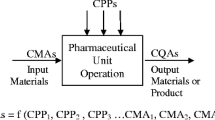Abstract
This case study described a successful application of the quality by design (QbD) principles to a coupling process development of insulin degludec. Failure mode effects analysis (FMEA) risk analysis was first used to recognize critical process parameters (CPPs). Five CPPs, including coupling temperature (Temp), pH of desB30 solution (pH), reaction time (Time), desB30 concentration (Conc), and molar equivalent of ester per mole of desB30 insulin (MolE), were then investigated using a fractional factorial design. The curvature effect was found significant, indicating the requirement of second-order models. Afterwards, a central composite design was built with an augmented star and center points study. Regression models were developed for the CPPs to predict the purity and yield of predegludec using above experimental data. The R2 and adjusted R2 were higher than 96 and 93% for the two models respectively. The Q2 values were more than 80% indicating a good predictive ability of models. MolE was found to be the most significant factor affecting both yield and purity of predegludec. Temp, pH, and Conc were also significant for predegludec purity, while Time appeared to remarkably influence the yield model. The multi-dimensional design space and normal operating region (NOR) with a robust setpoint were determined using a probability-based Monte-Carlo simulation method. The verified experimental results showed that the design space was reliable and effective. This study enriches the understanding of acetylation process and is instructional to other complicated operations in biopharmaceutical engineering.






Similar content being viewed by others
References
US Food and DrugAdministration. Pharmaceutical CGMPs for the 21st century—arisk-based approach: final report. 2004. http://www.fda.gov/downloads/Drugs/DevelopmentApproval Process/Manufacturing/QuestionsandAnswersonCurrentGoodManufacturingPracticescGMPforDrugs/UCM176374.pdf. Accessed 12 Dec 2012.
ICH Q8 (R2). Pharmaceutical development. 2009. http://www.ich.org/products/guidelines/quality /article/quality-guidelines.html. Accessed 12 Dec 2012.
ICH Q9. Quality risk management. 2005. http://www.ich.org/products/guidelines/quality/ article/quality-guidelines.html. Accessed 12 Dec 2012.
ICH Q10. Pharmaceutical quality system. 2008. http://www.ich.org/products/guidelines/ quality/article/quality-guidelines.html. Accessed 12 Dec 2012.
Eon-duval A, Valax P, Solacroup T, Broly H, Gleixner R, Strat CL, et al. Application of the quality by design approach to the drug substance manufacturing process of an Fc fusion protein: towards a global multi-step design space. J Pharm Sci. 2012;101(10):3604–18. https://doi.org/10.1002/jps.23273.
Gong X, Chen H, Chen T, Qu H. Unit operation optimization for the manufacturing of botanical injections using a design space approach: a case study of water precipitation. PLoS One. 2014;9(8):e104493. https://doi.org/10.1371/journal.pone.0104493.
Zhang L, Yan B, Gong X, Yu LX, Qu H. Application of quality by design to the process development of botanical drug products: a case study. AAPS PharmSciTech. 2013;14(1):277–86. https://doi.org/10.1208/s12249-012-9919-8.
Lourenco V, Lochmann D, Reich G, Menezes JC, Herdling T, Schewitz J. A quality by design study applied to an industrial pharmaceutical fluid bed granulation. Eur J Pharm Biopharm. 2012;81(2):438–47. https://doi.org/10.1016/j.ejpb.2012.03.003.
Zidan AS, Sammour OA, Hammad MA, Megrab NA, Habib MJ, Khan MA. Quality by design: understanding the formulation variables of a cyclosporine A self-nanoemulsified drug delivery systems by Box-Behnken design and desirability function. Int J Pharm. 2007;332(1–2):55–63. https://doi.org/10.1016/j.ijpharm.2006.09.060.
Gupta S, Jhawat V. Quality by design (QbD) approach of pharmacogenomics in drug designing and formulation development for optimization of drug delivery systems. J Control Release. 2017;245:15–26. https://doi.org/10.1016/j.jconrel.2016.11.018.
Pathak M, Dutta D, Rathore A. Analytical QbD: development of a native gel electrophoresis method for measurement of monoclonal antibody aggregates. Electrophoresis. 2014;35(15):2163–71. https://doi.org/10.1002/elps.201400055.
Chen XC, Zhou L, Gupta S, Civoli F. Implementation of design of experiments (DOE) in the development and validation of a cell-based bioassay for the detection of anti-drug neutralizing antibodies in human serum. J Immunol Methods. 2012;376(1–2):32–45. https://doi.org/10.1016/j.jim.2011.11.004.
Nagashima H, Watari A, Shinoda Y, Okamoto H, Takuma S. Application of a quality by design approach to the cell culture process of monoclonal antibody production, resulting in the establishment of a design space. J Pharm Sci. 2013;102(12):4274–83. https://doi.org/10.1002/jps.23744.
Rouiller Y, Solacroup T, Deparis V, Barbafieri M, Gleixner R, Broly H, et al. Application of quality by design to the characterization of the cell culture process of an Fc-fusion protein. Eur J Pharm Biopharm. 2012;81(2):426–37. https://doi.org/10.1016/j.ejpb.2012.02.018.
Agarabi CD, Schiel JE, Lute SC, Chavez BK, Boyne MT, Brorson KA, et al. Bioreactor process parameter screening utilizing a Plackett–Burman design for a model monoclonal antibody. J Pharm Sci. 2015;104(6):1919–28.
Amadeo I, Mauro L, Orti E, Forno G. Establishment of a design space for biopharmaceutical purification processes using DoE. Methods Mol Biol (Clifton, NJ). 2014;1129:11–27. https://doi.org/10.1007/978-1-62703-977-2_2.
Jiang C, Flansburg L, Ghose S, Jorjorian P, Shukla AA. Defining process design space for a hydrophobic interaction chromatography (HIC) purification step: application of quality by design (QbD) principles. Biotechnol Bioeng. 2010;107(6):985–97. https://doi.org/10.1002/bit.22894.
Razinkov VI, Treuheit MJ, Becker GW. Accelerated formulation development of monoclonal antibodies (mAbs) and mAb-based modalities: review of methods and tools. J Biomol Screen. 2015;20(4):468–83. https://doi.org/10.1177/1087057114565593.
Jameel F, Hershenson S, Khan MA, Martin-Moe S. Quality by design for biopharmaceutical drug product development. New York: Springer; 2015.
Wang F, Surh J, Kaur M. Insulin degludec as an ultralong-acting basal insulin once a day: a systematic review. Diabetes Metab Syndr Obes. 2012;5:191–204. https://doi.org/10.2147/DMSO.S21979.
Greig SL, Scott LJ. Insulin degludec/liraglutide: a review in type 2 diabetes. Drugs. 2015;75(13):1523–34. https://doi.org/10.1007/s40265-015-0448-0.
Zain H, Ahmad M, Gardner QA, Akhtar M. Hierarchy of N-acylation sites in human insulin studied by RP-HPLC and mass spectrometry. J Chem Soc Pak. 2015;37(6):1249–55.
Vesper JL. Risk assessment and risk management in the pharmaceutical industry. PDA/DHI: Arlington; 2006.
Gong X, Zhang Y, Pan J, Qu H. Optimization of the ethanol recycling reflux extraction process for saponins using a design space approach. PLoS One. 2014;9(12):e114300. https://doi.org/10.1371/journal.pone.0114300.
Baker JC, Chen VJ, Hanquier JM, Kriauciunas A, Moser BA, Shuman RT. Selective acylation of epsilon-amino groups. US Patents 5646242; 8 July 1997.
Rozet E, Lebrun P, Hubert P, Debrus B, Boulanger B. Design spaces for analytical methods. TrAC Trends Anal Chem. 2013;42(1):157–67. https://doi.org/10.1016/j.trac.2012.09.007.
Author information
Authors and Affiliations
Corresponding author
Rights and permissions
About this article
Cite this article
Nie, L., Hu, M., Yan, X. et al. Optimization of a Coupling Process for Insulin Degludec According to a Quality by Design (QbD) Paradigm. AAPS PharmSciTech 19, 2185–2194 (2018). https://doi.org/10.1208/s12249-018-1032-1
Received:
Accepted:
Published:
Issue Date:
DOI: https://doi.org/10.1208/s12249-018-1032-1




